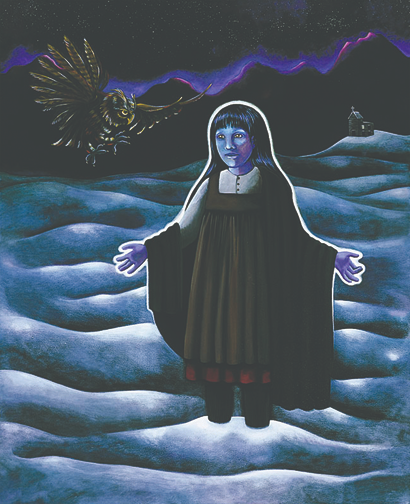Overview
Artist Judith Lowry (Mountain Maidu, Pit River)

Author: Frank Tuttle, (Yuki/Concow Maidu) Artist, Educator, and Ceremonial Leader, Maggie Peters (Yurok and Karuk), Native American Studies Model Curriculum Learning Specialist Humboldt County Office of Education
Grade(s): 5-8
Suggested Amount of Time: 90 minutes or two 45 minute sessions
Curriculum Themes
- History
- Cultural Strengths
- Relationship to Place
Learning Goals
Students will understand that through artwork, artists share cultural backgrounds, insights, and in Judith Lowry’s case, storytelling (artmaking) always carries an important message.
Students will learn about the boarding school experience through the artwork of Judith Lowry.
Students will learn about the shared role in traditional and contemporary storytelling in modern society
Lesson Overview
In this lesson, students will learn about Judith Lowry, a Native American artist whose work powerfully reflects her cultural heritage and important moments in Native history. We will begin by reading a short biography to understand her life story, including how her mixed background and experiences have influenced her art. Then, students will explore several of Lowry’s vibrant paintings, using them as a window into Native perspectives and stories that are often overlooked or misunderstood. Through guided discussion and observation, students will discover how Lowry uses her art to challenge stereotypes, celebrate Native identity, and bring attention to the challenges Native communities face today. This lesson aims to help students appreciate art as a form of storytelling and social activism, while inspiring them with the creative strength and resilience of Judith Lowry and other Native artists.
Teacher Background
When teaching Native American history and perspectives, it is vital to center Indigenous voices and approaches that honor their cultural knowledge, storytelling traditions, and lived experiences. Art is a powerful way to explore these perspectives because Native artists often serve as visual social commentators—sharing stories that challenge stereotypes, reveal hidden histories, and reflect ongoing political, social, and cultural realities.
Visual artists throughout history have used their work to comment on important world events and social issues. For example, Spanish painters Pablo Picasso and Francisco Goya depicted the horrors of civil war; Jean-Michel Basquiat’s work brought attention to racism and poverty; and Judy Chicago highlighted feminist ideas. Similarly, Native American artists have long played this role by bridging cultural worldviews and contesting one-dimensional, often harmful, labels imposed by outsiders.
From early ceremonial wampum belts used by Indigenous peoples to record treaties and histories, to the ledger art of Great Plains warrior artists, Native visual storytelling has been central to documenting and interpreting their place in American society. Today, contemporary artists like Jaune Quick-to-See Smith continue this tradition, using art to engage in dialogue about Native identity and political challenges.
Since the mid-1960s, Native California artists have emerged strongly on the broader American Indian art scene, using their work to express the rich diversity of Native California’s cultures and their deep connections to land, community, and spirituality. Artists such as Frank Day, Frank LaPena, Dal Castro, George Blake, Karen Noble Tripp, Harry Fonseca, Jean LaMarr, Brian Tripp, and Frank Tuttle have grounded their art firmly in their cultural traditions and community knowledge, creating a unique and authentic Native California artistic voice.
Judith Lowry is an important figure among these artists. Her artwork goes beyond surface images to reveal stories that often remain hidden or overlooked. She champions the rights and strength of Native women, addressing the contradictions and challenges Native people face today. Lowry’s paintings serve as both a continuation of oral tradition and a form of activism, offering viewers a window into Native American experiences that are nuanced, complex, and vital.
When teaching through Lowry’s work, educators should prioritize respectful cultural context, emphasize Indigenous storytelling, and recognize the ongoing role of Native artists as commentators and protectors of their histories and identities. This approach helps students understand art not only as creative expression but also as a meaningful way to explore history, culture, and social justice.

